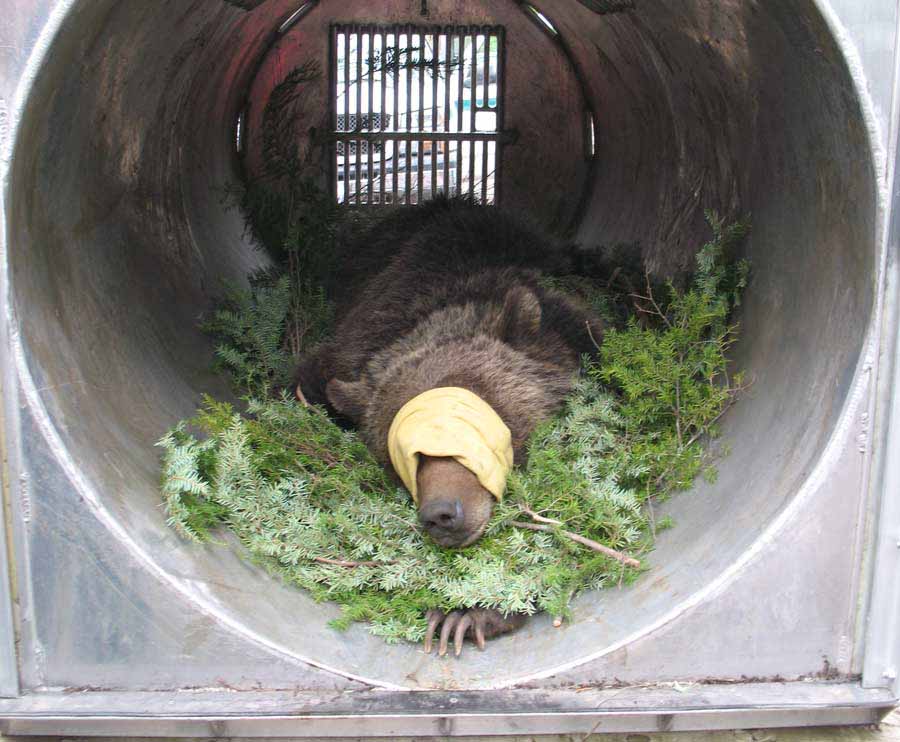
A tranquilized grizzly bear lies in a trap similar to those used for capturing nuisance bears in Grand Teton National Park and surrounding areas. (NPS photo - click to enlarge)
From Staff Reports
Grand Teton National Park managers are warning visitors to steer clear of trap sites this summer where bears are being captured as part of ongoing bear management operations, and to follow basic rules for staying safe in bear country.
A small number of “nuisance bears” throughout Grand Teton National Park and the John D. Rockefeller, Jr. Memorial Parkway may be captured for relocation or to be euthanized, according to a statement released by the park’s public affairs office.
Wildlife managers sometimes capture black and grizzly bears that have become habituated to humans, exploit human-related food sources or have a history of conflict with people, pets or livestock. Nuisance bears may be relocated to another spot in the greater Yellowstone area or, in some cases, put down.
Wherever bears are being trapped, the area around the site will be closed to public entry and posted with prominent warning signs. These signs will be posted along major access points to the trapping site. Park officials remind all visitors and residents to comply with any posted closure, and not venture into any closed area or approach a trap.
Bears generally pose a safety concern only after they start to associate people and their activities with easily obtained food. This can occur if campers do not store food properly, or if pet food, loose garbage or other bear attractants are not secured in residential areas in bear country.
Two Yellowstone Park backcountry hikers were fatally mauled last summer in separate incidents involving the same grizzly bear, and land management officials across the region are taking pains this summer to stress bear safety as a priority.
Wildlife officials studying grizzly bears previously did not alert the public via notices to regional news media about trapping operations. But researchers changed that policy after botanist Erwin Evert was killed by a grizzly bear in June 2010 near Kitty Creek in the Shoshone National Forest, just east of the east entrance to Yellowstone National Park. The bear had been trapped and drugged as part of a government study and was released just before the fatal attack. Evert’s family has filed a wrongful death lawsuit against the federal government.
Grand Teton officials advise all visitors to read and follow bear safety information posted throughout the park, and to take personal responsibility for securing food and other attractants while traveling or camping in bear country.
Black and grizzly bears are active at all hours throughout the park, including in campgrounds and heavily used developed areas like visitor centers and lodges.
While in the park, visitors should:
- Use available storage facilities when camping or secure food in cars.
- Dispose of garbage in bear-proof garbage cans provided at all campgrounds and picnic areas.
- Never leave food or backpacks unattended.
- Be alert and make noise while hiking.
- Avoid hiking alone.
- Never run from a bear.
- Carry bear spray when hiking.
Contact Yellowstone Gate at 307-213-9818 or info@yellowstonegate.com.

Another article that clearly illustrates how “endangered” grizzly bears are in the yellowstone area. Anyone who gives any credibility to the greater yellowstone coalition, the ninth circuit court of appeals, and the u s fish and wildlife service is extremely misinformed.
Wow, that’s an interesting conclusion…a great white shark just attacked a guy in Massachusets and I don’t think that clearly shows the sharks are no longer endangered.